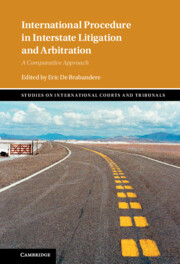Book contents
- International Procedure in Interstate Litigation and Arbitration
- Studies on International Courts and Tribunals
- International Procedure in Interstate Litigation and Arbitration
- Copyright page
- Contents
- Contributors
- Introduction
- Part I Pre-hearing and Selection and Appointment of Judges and Arbitrators
- Part II Post-commencement Litigation Procedure and Strategy
- 5 Interim Measures
- 6 Procedural Challenges and Strategies before the ICJ and ITLOS
- 7 Achieving Greater Access to Justice through Cost-Efficiency
- 8 Opening Up International Adjudication
- Part III Evidence and Witness
- Part IV Post-hearing and Effect of Decisions
- Index
8 - Opening Up International Adjudication
Mapping Procedural Transparency in International Disputes
from Part II - Post-commencement Litigation Procedure and Strategy
Published online by Cambridge University Press: 18 November 2021
- International Procedure in Interstate Litigation and Arbitration
- Studies on International Courts and Tribunals
- International Procedure in Interstate Litigation and Arbitration
- Copyright page
- Contents
- Contributors
- Introduction
- Part I Pre-hearing and Selection and Appointment of Judges and Arbitrators
- Part II Post-commencement Litigation Procedure and Strategy
- 5 Interim Measures
- 6 Procedural Challenges and Strategies before the ICJ and ITLOS
- 7 Achieving Greater Access to Justice through Cost-Efficiency
- 8 Opening Up International Adjudication
- Part III Evidence and Witness
- Part IV Post-hearing and Effect of Decisions
- Index
Summary
Transparency is central in current policy debates about international law. One sees it being waved as a flag or wielded as a sword in debates on the legitimacy of international institutions and their role in global governance. Its proponents talk about ‘sunlight being the best disinfectant’, while its opponents see it as changing modern diplomacy. Due to their crucial role in gatekeeping international commitments, these debates have also touched on the issue of transparency in international adjudicating bodies. This has led to fruitful legal and normative analysis of the state of the art of transparency in international courts. This chapter attempts to contribute to these debates by assessing three understudied aspects of transparency in the international adjudication debate. Firstly, adding to the previous literature, this chapter attempts to make a different, though cumulative, case for why transparency in international adjudication matters. It does so by showing how most theories of compliance with international law as well as theories of compliance with international legal rulings are very much information-dependent. If one takes the step of accepting that more transparency leads to more information, then whether or not a dispute is open to the general public becomes relevant for reasons beyond its normative value. It also becomes a question of compliance. Secondly, in line with previous literature on the topic, this chapter provides a theoretically informed survey of the design of procedural rules associated with transparency at the main global adjudicating bodies. Specifically, it does so by assessing design features, which are expected to impact transparency outcomes: whether the rule is mandatory or a default-rule, status quo option; agenda-setters and the scope for possible shifts from the status quo; and the number of veto-players. Finally, the chapter goes beyond the rules of international adjudicating bodies and assesses transparency outcomes in 1,248 disputes at eight major adjudicating bodies across several issue areas. Using online disclosures by international adjudicating bodies as an empirical case study, this chapter provides a novel and comprehensive map of de facto transparency in international disputes. By doing so, it shows that rule-based assessments of how transparent an international adjudicating body is may be misleading.
- Type
- Chapter
- Information
- International Procedure in Interstate Litigation and ArbitrationA Comparative Approach, pp. 230 - 260Publisher: Cambridge University PressPrint publication year: 2021



